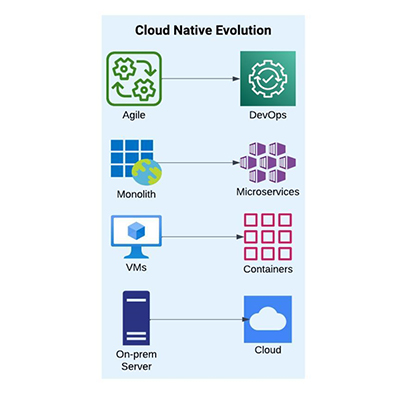Exploring Scalability in Enterprise Application Development — A Cloud-Native Approach | Prof. Shreyas Suresh Rao| Associate Professor| BITS Pilani -Work Integrated Learning Programmes (WILP) division
 Gartner predicts that 85% of enterprises will embrace cloud-native application development by 2025, with global cloud revenue estimated to touch $692 Billion. Building scalable applications, with agility and resilience, will be the key enablers for digital business acceleration across the world. It is therefore imperative for enterprises to upskill their workforce with the knowledge of Microservices, Containerization, DevOps, etc., in order to transition to cloud-native development.
Gartner predicts that 85% of enterprises will embrace cloud-native application development by 2025, with global cloud revenue estimated to touch $692 Billion. Building scalable applications, with agility and resilience, will be the key enablers for digital business acceleration across the world. It is therefore imperative for enterprises to upskill their workforce with the knowledge of Microservices, Containerization, DevOps, etc., in order to transition to cloud-native development.
As we delve deeper into how a cloud-native approach can enhance scalability in enterprise applications, to begin with, we shall examine the need for scalability in enterprise application development. Subsequently, we shall explore the concept of cloud-native development and its evolution, before finally assessing the current tools and technologies that are driving this adoption.
Need for Scalability in Enterprise Application Development
Scalability is a critical non-functional characteristic in distributed systems that enables them to adapt to expansion. In various domains, such as banking or social media, ‘expansion’ may entail managing an increased volume of concurrent users or requests, or it may involve enhancing the system’s capacity to process extensive parallel transactions, as seen in generative AI applications, such as ChatGPT. Scalability is a fundamental requirement for various enterprises, including those in food delivery, OTT, social media, and e-commerce areas.
Cloud-Native Development and its Evolution
Over the past two decades, enterprises have embarked on a transformative digital journey to modernize their operations, enhance customer experiences, and maintain competitiveness with resilience. Within this evolution, enterprise application development has progressed in four key areas — development processes, application architecture, deployment processes, and infrastructure, as depicted in figure.
The Rise of Agile DevOps
Agile has emerged as the preferred methodology for software development and project management, and it incorporates DevOps practices to automate various aspects of the development, testing, integration, and deployment processes. This combined approach leads to shorter development and release cycles, resulting in faster deployment.

Monolith to Microservices Transformation
Traditionally, applications were constructed using monolithic approaches, where all the components were tightly integrated into a single codebase. This approach had significant implications on scalability, fault tolerance, and reliability. To address these limitations, more enterprises are embracing the microservices architecture. In this paradigm, applications are composed of small and autonomous services that can be independently designed, developed, tested, and deployed into production.
Movement from Cloud Virtualization to Containerization
Unlike traditional virtualization where hypervisors virtualize the physical hardware, in containerization, containers virtualize the operating system, so as to contain the application along with dependent libraries. One can use container orchestration systems, such as Kubernetes or Docker Swarm to automate the processes of container management, scaling, and routing.
Containerization enables the adoption of “Microservices” architecture, which can improve resilience and expedite time to market. Being device- and platform-agnostic, microservices offer consistent user experience across mobile, web, and wearable environments.
As one of the first success cases, Walmart Canada was able to handle a transaction of 6 million page views per minute by adopting the microservices architecture. This success was replicated by several multinational companies, such as Amazon, NetFlix, PayPal, Twitter and eBay, using microservices. In fact, DevOps practices of continuous integration and delivery is an enabler for microservices deployments. According to the Phoenix Project report (2021), Amazon and Google have embraced Cloud Native best practices, such as DevOps and containers, resulting in Amazon conducting 23,000 micro deployments per day and Google performing 5,500 deployments on a daily basis.
Digital Strategy Acceleration through Cloud Enablement
Traditionally, in the past, many enterprises adopted the “on-premises” software deployment model for reasons, such as cost control, security, and compliance. However, in recent times, cloud providers have addressed these concerns by offering data encryption, data ownership SLAs, cloud cost optimization strategies, and adherence to compliance standards.
Consequently, now is the ideal moment for enterprises to embrace the “hybrid” cloud model, which combines the security and data ownership benefits of private cloud or on-premise data hosting with the cost-effectiveness and scalability of the public cloud. Hybrid integration promises a scalable infrastructure that supports (a) storing large amounts of data in data lakes (b) cloud analytics and (c) on-demand computing.
Tools and Technologies that are Driving Cloud-Native Adoption
Cloud native development relies on a combination of containerization, container orchestration, auto-scaling, and load balancing, often complemented by server-less computing, to achieve seamless scalability. These technologies empower applications to adapt to varying workloads and ensure high availability, while minimizing operational overhead.
Containerization is a foundational technology, and tools like Docker have gained widespread adoption. Containers provide a consistent and lightweight environment for applications, making it easier to deploy and manage them across various cloud platforms. Kubernetes, a prominent container orchestration platform, is utilized for automating the deployment, scaling, and management of containerized applications. Kubernetes enables developers to define how their application should scale and be distributed, making it an essential component for achieving scalability.
Auto-scaling is another crucial feature in cloud native development. Technologies, such as AWS Auto Scaling and Azure Autoscale, allow applications to dynamically adjust the number of resources they consume, based on real-time demand. When traffic spikes, additional resources are automatically provisioned; and when demand decreases, excess resources are released, optimizing cost-efficiency and maintaining consistent performance.
Load balancing tools, such as AWS Elastic Load Balancing and NGINX, are employed to distribute incoming network traffic across multiple instances of an application or service. This ensures that requests are evenly distributed, preventing any single component from becoming a bottleneck. Load balancing is essential for achieving high availability and efficient resource utilization in scalable cloud-native applications.
Additionally, server-less computing platforms, such as AWS Lambda and Azure Functions, provide an event-driven architecture that automatically adjusts resource allocation in response to incoming events or requests. This allows developers to concentrate on writing code, without the need to be concerned about server provisioning or maintenance, resulting in an efficient and automated scalability.
Cloud Native Development to Redefine Enterprise Application Development
In an era characterized by constant change, the need for scalability in enterprise applications has transformed from being an optional feature to an absolute necessity. The cloud native approach, with its focus on containerization, microservices, and DevOps practices, offers a powerful solution to this challenge.
Working professionals keen on mastering cloud native development, should consider exploring training programs and certifications in the following areas — Software Architecture (Microservices, SOA), DevOps practices, Container platforms (Docker, Kubernetes, OpenShift), and Cloud platforms (AWS, Azure, Google Cloud). Acquiring knowledge in these areas shall empower professionals to architect scalable, resilient, and cost-effective solutions in the cloud-native ecosystem. By enabling their organisations to scale rapidly, achieve fault tolerance, and reduce costs, professionals can indeed help cloud native development reshape the future of enterprise application development.
The real-world success stories of companies, such as Hotstar, Netflix, Spotify, and Uber, serve as compelling evidence of the benefits of a cloud native approach. As more organisations continue to explore and embrace this transformative approach, they certainly position themselves to address the demands of the digital age head-on — and all this, with a level of flexibility and adaptability that was previously unimaginable.


